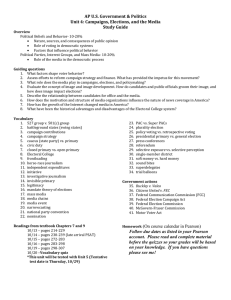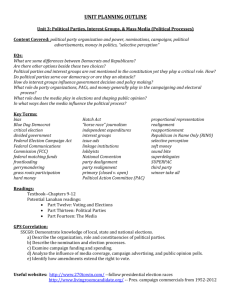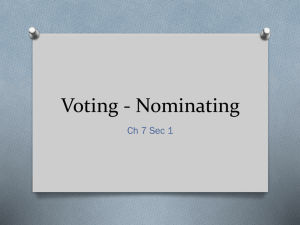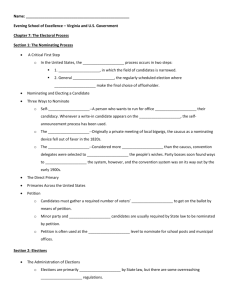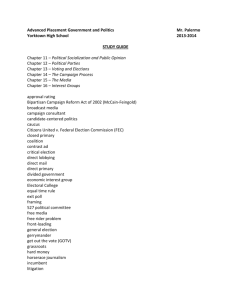Magruder's American Government
advertisement
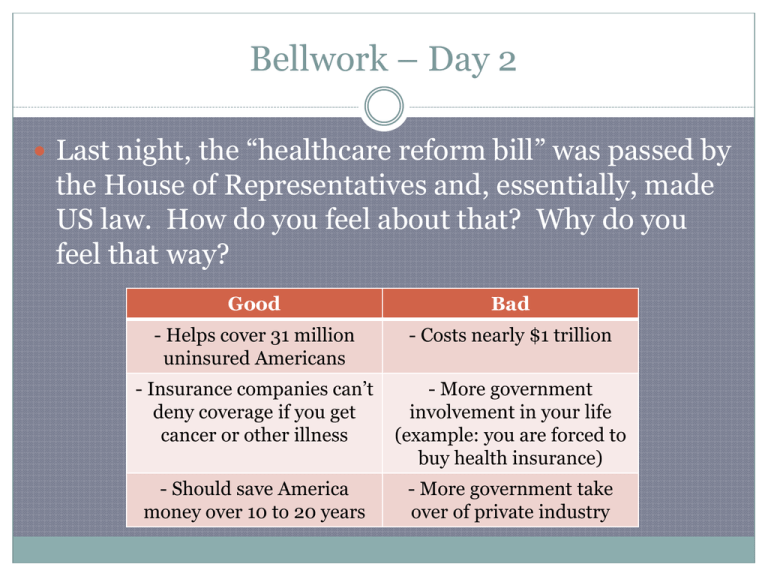
Bellwork – Day 2 Last night, the “healthcare reform bill” was passed by the House of Representatives and, essentially, made US law. How do you feel about that? Why do you feel that way? Good Bad - Helps cover 31 million uninsured Americans - Costs nearly $1 trillion - Insurance companies can’t deny coverage if you get cancer or other illness - More government involvement in your life (example: you are forced to buy health insurance) - Should save America money over 10 to 20 years - More government take over of private industry Political Party Project: Add the due dates below to your calendar Task #4 - March 24 (or today if you have it) Create a party leader to run for president. Give your leader a name, gender, age, education, work experience, and political experience. Provide a detailed explanation of why this person was chosen to lead the party. This writing piece should be at least 200 words in length. Task #5 - March 24 A campaign poster: name of party, name of party leader or candidate running in a riding, party’s logo, and party's slogan. Task #8 - March 24 A campaign flyer or brochure: It should include the name of party, name of party leader or candidate running in a riding, party’s logo, party's slogan, and a brief summary of the party's platform Task #6 - March 26 A radio or television commercial: outlines creatively in a 40 second commercial the party’s platform. It must be written out as well as presented. Task #7 - April 1 An election speech: to be delivered on election day. It should be persuasive and informative (maximum 5 minutes). The speech must also be submitted in written form. Election Day is April 1, 2010 Assignment 7: Chapter 7 Notes THE ELECTORAL PROCESS SECTION 1 The Nominating Process Why is the nominating process a critical first step in the election process? What are self-announcement, the caucus, and the convention nominating methods? Why is the direct primary the principal nominating method used in the United States today? Why do some candidates use the petition as a nominating device? Chapter 7, Section 1 A Critical First Step In the United States, the election process occurs in two steps: 1. Nomination, in which the field of candidates is narrowed 2. General election, the regularly scheduled election where voters make the final choice of officeholder Chapter 7, Section 1 Nominating and Electing a Candidate Chapter 7, Section 1 Three Ways to Nominate Self-Announcement – A person who wants to run for office announces their candidacy. Whenever a write-in candidate appears on the ballot, the self-announcement process has been used. The Caucus – Originally a private meeting of local bigwigs, the caucus as a nominating device fell out of favor in the 1820s. The Convention – Considered more democratic than the caucus, convention delegates were selected to represent the people’s wishes. Party bosses soon found ways to manipulate the system, however, and the convention system was on its way out by the early 1900s. Chapter 7, Section 1 The Direct Primary Types of Direct Primaries Closed Primary Open Primary Only declared party members can vote. Any qualified voter can take part. Runoff Primary If a required majority is not met, the two people with the most votes run again Nonpartisan Primary Candidates are not identified by party labels Blanket Primary Qualified voters can vote for any candidate, regardless of party Chapter 7, Section 1 Primaries Across the United States Chapter 7, Section 1 Petition Candidates must gather a required number of voters’ signatures to get on the ballot by means of petition. Minor party and independent candidates are usually required by State law to be nominated by petition. Petition is often used at the local level to nominate for school posts and municipal offices. Chapter 7, Section 1 Section 1 Review 1. The most commonly used method of nomination today is (a) the caucus. (b) the direct primary. (c) self-announcement. (d) the convention. 2. A runoff primary is held in some States when (a) no one wins a majority of votes. (b) there is only one candidate. (c) not enough voters turn out on election day. (d) a candidate asks for a recount. Chapter 7, Section 1 SECTION 2 Elections How does the administration of elections in the United States make democracy work? What role do precincts and polling places play in the election process? In what ways can voters cast their ballots? What role do voting machines and other innovations play in the election process? Chapter 7, Section 2 The Administration of Elections Elections are primarily regulated by State law, but there are some overreaching federal regulations. Congress has the power to set the time, place, and manner of congressional and presidential elections. Congress has chosen the first Tuesday after the first Monday in November of every even-numbered year for congressional elections, with the presidential election being held the same day every fourth year. States determine the details of the election of thousands of State and local officials. Most States provide for absentee voting, for voters who are unable to get to their regular polling places on election day. Some States within the last few years have started to allow voting a few days before election day to increase voter participation. Chapter 7, Section 2 Precincts and Polling Places Precincts A precinct is a voting district. Precincts are the smallest geographic units used to carry out elections. A precinct election board supervises the voting process in each precinct. Polling Places A polling place is where the voters who live in a precinct go to vote. It is located in or near each precinct. Polling places are supposed to be located conveniently for voters. Chapter 7, Section 2 Casting the Ballot History of the Ballot Voting was initially done orally. It was considered “manly” to speak out your vote without fear of reprisal. Paper ballots began to be used in the mid-1800s. At first, people provided their own ballots. Then, political machines began to take advantage of the flexibility of the process to intimidate, buy, or manufacture votes. In the late 1800s, ballot reforms cleaned up ballot fraud by supplying standardized, accurate ballots and mandating that voting be secret. Split ticket voting: when you vote for candidates from different parties in the same election Chapter 7, Section 2 Office-Group and Party-Column Ballots 1 3 Chapter 7, Section 2 Voting Machines and Innovations • • • Electronic vote counting has been in use since the 1960s. Punch-card ballots are often used to cast votes. Vote-by-mail elections have come into use in recent years. Online voting is a trend that may be encountered in the near future. Chapter 7, Section 2 Section 2 Review 1. Elections are held on (a) the first Wednesday after Halloween. (b) the first Tuesday after the first Monday in November. (c) the second Thursday after the first Monday in March. (d) the first Monday in December. 2. The Office-Group Ballot encourages (a) voter fraud. (b) split-ticket voting. (c) voter dissatisfaction. (d) the Democratic Party. 1 3 Chapter 7, Section 2 SECTION 3 Money and Elections What are the issues raised by campaign spending? What are the various sources of campaign funding? How do federal laws regulate campaign finance? What role does the Federal Election Commission have in enforcing campaign finance laws? What loopholes exist in today’s campaign finance laws? Chapter 7, Section 3 Campaign Spending 1 2 Chapter 7, Section 3 Sources of Funding Private and Public Sources of Campaign Money Small contributors Nonparty groups such as PACs Wealthy supporters Temporary fund-raising organizations Candidates Government subsidies Chapter 7, Section 3 Regulating Campaign Financing Early campaign regulations were created in 1907, but feebly enforced. The Federal Election Campaign Act (FECA) of 1971 was passed to replaced the former, ineffective legislation. The FECA Amendments of 1974 were passed in response to the Watergate scandal. Buckley v. Valeo invalidated some of the measures in the FECA Amendments of 1974. Most significantly, it also stipulated that several of the limits that the 1974 amendments placed on spending only apply to candidates who accept campaign money from the government, not those who raise money independently. The FECA Amendments of 1976 were passed in response to Buckley v. Valeo. Chapter 7, Section 3 The Federal Election Commission The Federal Election Commission (FEC) enforces: the timely disclosure of campaign finance information limits on campaign contributions limits on campaign expenditures provisions for public funding of presidential campaigns Chapter 7, Section 3 Loopholes in the Law “More loophole than law…” —Lyndon Johnson Soft money—money given to State and local party organizations for “party-building activities” that is filtered to presidential or congressional campaigns. $500 million was given to campaigns in this way in 2000. Independent campaign spending—a person unrelated and unconnected to a candidate or party can spend as much money as they want to benefit or work against candidates. Issue ads—take a stand on certain issues in order to criticize or support a certain candidate without actually mentioning that person’s name. Chapter 7, Section 3 Section 3 Review 1. Sources of campaign funding include (a) nonparty groups, such as political action committees. (b) government subsidies. (c) candidates’ personal funds. (d) all of the above. 2. Under federal election legislature passed in the 1970s, candidates are not allowed to (a) take government subsidies. (b) use their own money in campaigns. (c) take contributions of more than $1,000. (d) all of the above. Chapter 7, Section 3
